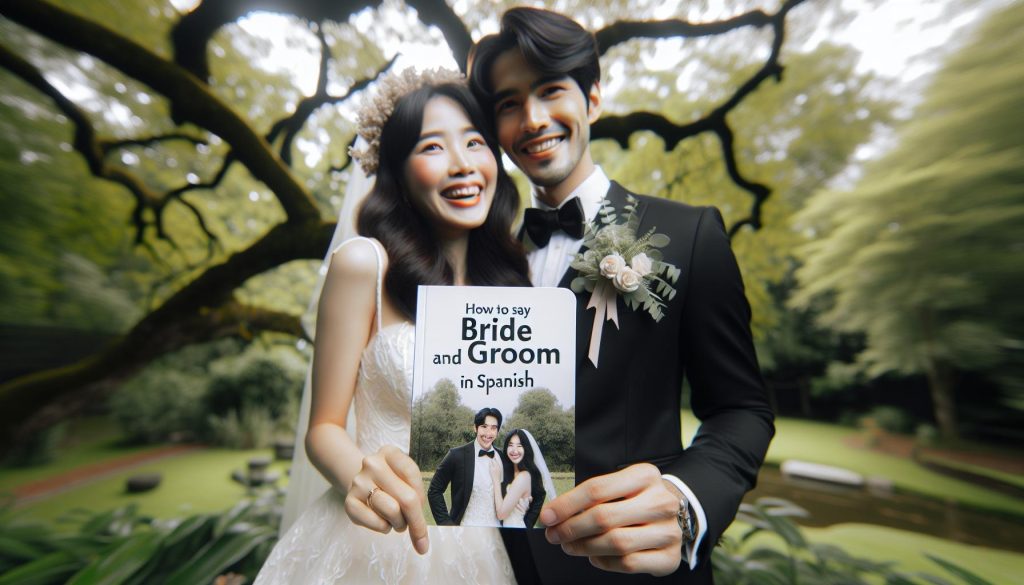Celebrating love knows no boundaries, especially when it comes to weddings. For couples planning a bilingual ceremony, knowing how to say “bride” and “groom” in Spanish enhances the cultural richness of their special day. As weddings create cherished memories, incorporating diverse traditions can reflect personal stories and shared values. Whether you’re looking to connect with Spanish-speaking guests or simply honor your heritage, this guide provides essential bilingual wedding terms that will make your ceremony more inclusive and memorable. Get ready to explore the beauty of blending languages, ensuring every word spoken on your big day resonates with love and unity.
How to Translate “Bride” and “Groom” in Spanish
When planning a wedding that blends cultures or languages, understanding how to accurately translate key terms can be both practical and symbolic. The words for “bride” and “groom” hold significant meanings in Hispanic cultures, and correctly using these translations can bring a personal touch to your ceremony. In Spanish, the word for bride is “novia,” while the term for groom is “novio.” These words not only denote the people involved in the marriage but are also steeped in tradition and celebration, reflecting the unique roles each plays in the wedding festivities.
Nuances and Context
While “novia” and “novio” are standard translations, it’s essential to consider the context in which you use them. In traditional Hispanic weddings, the bride often embodies grace and elegance, while the groom may symbolize strength and responsibility. This cultural backdrop can enrich your vows and exchanges during the ceremony, allowing for a genuinely heartfelt experience. Incorporating these terms in your wedding planning can help bridge the gap between languages and add depth to your celebration.
Furthermore, if you’re crafting your vows or wedding invitations, using “novia” and “novio” will allow your bilingual guests to connect on a deeper level. This thoughtful inclusion fosters a sense of unity and respect for the diverse backgrounds of your loved ones. As such, when approaching elements like vows, invitations, or speeches, take the time to familiarize yourself with these terms, ensuring they resonate beautifully within the larger narrative of your love story.
Think about including phrases such as “mi novia” (my bride) or “mi novio” (my groom) in your ceremony. This personal touch can make each mention feel more intimate and significant, highlighting the love and commitment that defines this special occasion.
Cultural Significance of Wedding Vocabulary

To articulate the beauty of weddings in Spanish-speaking cultures, it’s essential to grasp the rich significance behind the terms “novia” and “novio.” These words transcend mere labels; they embody the emotional and cultural essence of marital union. In many Hispanic traditions, the words for bride and groom are imbued with symbolism that reflects societal roles and familial expectations. For instance, the term “novia” connotes grace, beauty, and reverence, while “novio” suggests strength, protection, and a commitment to family and service. This linguistic depth can elevate the entire wedding experience, making it feel more significant.
Integrating these Spanish terms into your wedding can also serve as a bridge between cultures, fostering inclusivity among your guests. Using “novia” and “novio” in various parts of your ceremony-from vows to invitations-allows bilingual attendees to feel more connected to the proceedings. For instance, crafting your vows to include intimate phrases like “mi novia” and “mi novio” can invoke deeper emotional reactions, reflecting a shared journey between partners and celebrating the union that embodies love and understanding.
Furthermore, exploring the diverse Spanish wedding vocabulary opens a window into unique customs and practices that can enhance your celebration. Terms associated with specific rituals-such as “la ceremonia” (the ceremony) or “el baile” (the dance)-can enhance your understanding of how these elements fit into your special day. Respecting these cultural nuances can add layers of meaning and provide a memorable experience that honors both your heritage and those of your loved ones, ensuring that every detail resonates with significance.
Essential Bilingual Wedding Terms You Need

Integrating bilingual terminology into your wedding planning can significantly enrich the experience for both you and your guests. Understanding essential terms such as “novia” (bride) and “novio” (groom) is just the beginning of infusing your ceremony with cultural significance. Embracing Spanish vocabulary can enhance communication and connection for bilingual attendees, inspiring inclusivity and love as you celebrate your union.
To create an engaging bilingual celebration, familiarize yourself with essential wedding terms that often come up in ceremonies and traditions. Here’s a list of vital vocabulary to incorporate into your wedding:
- La ceremonia – The ceremony
- Las alianzas – The wedding rings
- El vestido de novia – The bride’s dress
- El ramo – The bouquet
- El cortejo nupcial – The bridal party
- Los votos – The vows
- La recepción – The reception
- El baile – The dance
Using these terms throughout your ceremony and reception can deepen the cultural experience. For example, consider integrating your vows in both languages. Expressing your commitment with phrases like “Te prometo” (I promise you) alongside heartfelt declarations in English can resonate with diverse guests, making every word feel more profound.
As you prepare your invitations, utilize bilingual wording to ensure that no guest feels left out. A simple yet elegant invitation could read: “You are cordially invited to the wedding of [Name] & [Name]” followed by its Spanish counterpart: “Estás cordialmente invitado a la boda de [Name] & [Name].” This thoughtful gesture sets the tone for an inclusive celebration right from the start.
Ultimately, weaving bilingual terms into your wedding not only enriches the experience for all attendees but also fosters an environment of unity and love, celebrating your cultural backgrounds alongside your journey as a couple. By incorporating these key terms, you’ll create a memorable event filled with emotional significance and respect for diverse traditions.
Commonly Used Spanish Wedding Phrases

Incorporating Spanish wedding phrases into your celebration not only enhances the atmosphere but also brings a deeper cultural richness to the event. Engaging your guests with these phrases helps foster an inclusive environment, ensuring that everyone feels connected to the joyous occasion. Here’s a collection of commonly used phrases that can inspire conversations, vows, and toasts throughout your bilingual wedding journey.
Essential Phrases for a Bilingual Wedding
- ¡Felicitaciones! – Congratulations!
- Te amo – I love you
- Estoy tan feliz de estar aquí hoy – I am so happy to be here today
- Que vivan los novios! – Long live the newlyweds!
- ¿Aceptas esta alianza? – Do you accept this ring?
- Nos unimos en matrimonio – We are united in marriage
- Siempre juntos – Always together
- Brindemos – Let’s toast!
These phrases can be strategically used during your ceremony, speeches, and celebrations. For example, consider starting your vows with “Te amo,” expressing your love in Spanish to bring a personal touch that resonates with guests from different backgrounds.
When inviting guests to raise their glasses during a toast, shout “¡Brindemos!” to encourage everyone to join in the celebration. This involvement can create unforgettable moments that highlight the unity of different cultures and traditions.
As the big day approaches, familiarize yourself with these phrases to help ease any nerves and ensure that you’re ready to embrace the bilingual nature of your wedding. By using these expressions, you create a beautiful blend of languages that encapsulates your love story, inviting everyone to share in the magic of your union.
Understanding Regional Variations in Wedding Terms

Weddings are a beautiful tapestry of culture and language, and understanding the regional variations in wedding vocabulary can significantly enhance the celebration for couples and guests alike. In Spanish-speaking countries, the terms for “bride” and “groom” can vary not only by region but also by the formality of the language used. While the most common terms are “novia” for bride and “novio” for groom, local dialects and customs often reflect unique traditions that enrich the ceremony.
In Mexico, for instance, the terms remain largely the same, but the wedding customs may include vibrant mariachi music and specific rituals like the “lazo,” where a rope or ribbon is symbolically placed around the couple. In contrast, in Spain, the bride is often referred to as “la novia” and the groom as “el novio,” but Spanish weddings may emphasize different traditions, such as the “muy bien” toast that celebrates the union with a joyful affirmation.
Understanding these variations isn’t just about language; it also helps couples tailor their invitations, vows, and ceremonies to reflect their cultural backgrounds. When crafting bilingual vows, for example, consider using a blend of both formal and colloquial phrases that resonate with both families. Including local wedding terms can also provide guests with context, making the celebration even more inclusive.
Couples should also be aware of how traditions can shift within the same country; attitudes towards weddings can vary significantly between urban and rural areas. While both groups may use “novia” and “novio,” the incorporation of local customs-like regional attire, music choices, or specific ceremonies like the “boda de oro” (golden wedding)-can provide precious layers of meaning to the union. Engaging with these local variations ensures that the wedding reflects not only the couple’s love but also their heritage, creating a memorable experience for everyone involved.
Tips for Incorporating Spanish into Your Vows
Incorporating Spanish into your wedding vows not only adds a beautiful layer of personalization but also celebrates the rich cultural heritage that comes with it. As you plan this heartfelt moment, consider the emotions and sentiments you want to express, allowing the power of language to encapsulate your love story. Using simple yet meaningful phrases can resonate deeply, ensuring that both families feel included in the ceremony.
Begin by gathering essential wedding vows in Spanish that are not only faithful translations, but also carry the emotion of your commitment. Common phrases such as “Te elijo a ti” (I choose you) or “Te amo para siempre” (I love you forever) can serve as powerful anchors. To maintain clarity for all guests, consider alternating between English and Spanish. For instance, saying a line in English followed by its Spanish counterpart can create a flowing, harmonious exchange that encapsulates the essence of your vows.
You might also want to personalize the vows by incorporating specific cultural elements or traditions that resonate with you. For example, referencing the symbolism of the “lazo” (a ceremonial rope or ribbon) in your vows can highlight the unity and bond you share. Feel free to combine colloquial and formal expressions to reflect your personalities-this could mean sprinkling in playful phrases from your courtship alongside heartfelt declarations.
Lastly, rehearse these vows together in both languages. This not only ensures that the pronunciation feels natural but also enhances the emotional weight of each word. Remember, the act of sharing your vows in multiple languages is a beautiful testament to your journey together. Embrace this opportunity to create an unforgettable moment that honors both your love and your diverse backgrounds.
Bilingual Wedding Invitations: A Complete Guide
Creating bilingual wedding invitations is a heartfelt way to honor both your heritage and the diverse backgrounds of your guests. As couples increasingly aim for inclusivity in their celebrations, incorporating both English and Spanish can set the tone for a warm and welcoming event. Not only do bilingual invitations communicate the details of your special day, but they also reflect the beauty of unity between cultures.
When drafting your invitations, start by determining the essential details that need to be included in both languages. Here are some key elements to consider:
- Hosts: Clearly state who is hosting the event. This could be the parents of the couple or the couple themselves, for example, “John and Maria invite you to join them…” (John y Maria les invitan a unirse a ellos…).
- Event Details: Include the date, time, and location. As you include this information in both languages, ensure that your wording flows naturally in each language, maintaining grammatical accuracy.
- RSVP Instructions: Providing clear RSVP details is crucial, especially if you’re requesting responses by a certain date. Phrasing such as “Please respond by…” (Por favor, confirmen su asistencia antes del…) ensures every guest knows how to reply.
Design Considerations
When designing your invitations, keep in mind the aesthetics that represent both cultures. You can choose a color scheme that signifies love and celebration, such as golds or pastels, while including cultural symbols or motifs that resonate with your partnership. It could be traditional patterns from one culture complemented by modern designs from another, creating a vibrant and cohesive invitation.
Verbiage and Style
Choosing the right words for your invites is just as important as the layout. While you may want to stay traditional with formal language, don’t hesitate to add a personal touch. Consider phrases that reflect your journey together-such as your love story or shared interests. For example, “Together with their families” can be translated to “Juntos con sus familias” to maintain warmth and intimacy, making every guest feel valued and connected.
By carefully crafting and thoughtfully presenting your bilingual invitations, you’re not just informing guests of your wedding details; you’re also inviting them into a celebration that celebrates love, family, and cultural diversity. Embrace this beautiful blend of languages as you set the foundation for a magical day that honors both you and your loved ones.
How to Address Guests in Spanish for Your Wedding
Addressing your guests in Spanish at your wedding not only showcases your respect for their culture but also adds a personal touch to your celebration. Knowing how to say simple phrases and terms can create a warm atmosphere, making your guests feel welcomed and cherished. Whether you are addressing your family, friends, or colleagues, understanding the nuances of Spanish titles and expressions will enhance the overall experience of your bilingual wedding.
When inviting guests, start with the basic terms for family titles, which can vary slightly based on the region. Here are some common terms and titles you might use:
- Señor: Mr. (used for adult males)
- Señora: Mrs. (used for married women)
- Señorita: Miss (used for unmarried women)
- Estimado/a: Dear (used as a formal greeting)
It’s essential to match the level of formality with your relationship with the guest. For instance, “Estimado Juan” (Dear Juan) is respectful yet familiar for a friend, whereas “Señora González” is appropriate for older relatives. When addressing a couple, you can combine their titles: “Estimados Juan y María” (Dear Juan and María) flows graciously and acknowledges both individuals.
In your wedding program or place cards, you may also choose to include guests’ names alongside affectionate phrases such as “Bienvenidos” (Welcome) or “Gracias por estar aquí” (Thank you for being here). These small elements contribute to the ambiance of your celebration, emphasizing the joy you share on such a significant day.
Finally, consider the seating arrangement and how it may flow with your address. If you have family or friends who speak different dialects of Spanish, it’s worth taking a moment to recognize these variations. Understanding these details can enrich your guests’ experience and ensure that everyone feels included and honored during your wedding celebration. Each thoughtful choice you make enhances the feelings of unity, love, and appreciation that you wish to convey on this momentous occasion.
Creating a Bilingual Ceremony: Key Considerations
When planning a bilingual wedding ceremony, thoughtfully incorporating Spanish can create a truly inclusive and memorable experience for all your guests. The words for “bride” and “groom” translate to “novia” and “novio,” respectively, but the depth of your ceremony goes far beyond these simple terms. To create harmony and understanding between English and Spanish-speaking attendees, there are several essential considerations to keep in mind.
Choosing the right officiant is crucial; consider someone who is fluent in both languages to easily navigate the ceremony’s flow. This not only ensures that the vows and readings resonate with everyone present but also adds layers of meaning for couples wishing to honor both cultures. Incorporating bilingual elements in your vows, such as a shared commitment expressed in both languages, can enhance emotional connections. You can start with a short introduction in English and follow it up with the same sentiments in Spanish, allowing guests to feel part of the celebration regardless of their language preference.
Communication extends to printed materials as well. Ensure that your programs, signage, and any written materials include translations for key phrases and instructions. Using clear headings in both languages will guide guests through the ceremony seamlessly. Consider including translations for significant readings, songs, or poems performed during the ceremony; this not only enhances understanding but also fosters a shared literary and cultural appreciation.
Don’t forget the little things! Encourage guests to learn a couple of wedding-specific phrases to engage with the bilingual atmosphere. For instance, words like “¡Sí, quiero!” (Yes, I do!) and “Bienvenidos” (Welcome) can be sprinkled in throughout the ceremony. This interactive element invites all your guests to participate, turning your wedding into a beautiful fusion of cultures that celebrates love in its many forms. By weaving together languages and traditions, you create a ceremony that honors both your relationship and the diverse tapestry of your loved ones, making your special day all the more radiant.
Engaging Spanish-speaking Guests: Etiquette and Tips
Creating a bilingual wedding that honors both cultures not only enhances the celebration but also engages all your guests, especially those who are Spanish-speaking. Here are some thoughtful tips and etiquette guidelines to ensure that everyone feels welcome and included.
To start, it’s essential to recognize the cultural significance of your choices. Using the appropriate Spanish terms for “bride” and “groom”-“novia” and “novio”-sets a genuine tone for the ceremony. Alongside these terms, consider including other culturally meaningful phrases throughout the ceremony, such as “Dios te bendiga” (God bless you) or “Tu eres mi todo” (You are my everything). These small gestures create connections and show respect for your guests’ backgrounds.
Effective Communication
Communication is vital in any bilingual wedding. Ensure your officiant can switch between languages smoothly, allowing for seamless transitions. For printed materials like programs, place cards, and signage, utilizing a bilingual format greatly aids comprehension. Clear headings in both English and Spanish will help guide your guests through the day’s events. You might consider an outline that includes:
- Welcome Message: Include a friendly greeting in both languages.
- Schedule of Events: Clearly outline the sequence of ceremonies, reception, and any other significant moments.
- Key Phrases: Offer translations of common terms used throughout the ceremony.
Encouraging Guest Participation
Engagement can be amplified by encouraging your guests to participate in bilingual expressions. Including simple phrases such as “¡Bienvenidos!” (Welcome!) or “¡Vamos a celebrar!” (Let’s celebrate!) invites all guests to join in the joy of your union. Providing small cards with phrases in both languages can also encourage attendees to learn and use these expressions during the festivities.
Special moments during the ceremony can be enhanced by bilingual songs and readings. Consider choosing a special song that resonates in both languages, or select a poem that captures your relationship’s essence and can be beautifully articulated in both tongues. This not only reflects your love story but also celebrates the rich tapestry of your guests’ cultures.
Overall, an emphasis on inclusivity and cultural recognition will ensure your wedding is not just a celebration of love between two individuals, but a joyous occasion that unites diverse families and friends. Incorporating these elements thoughtfully will make for an unforgettable day filled with warmth, love, and shared laughter.
Fun Ways to Celebrate with Spanish Traditions
Celebrating a wedding with Spanish traditions can be a beautiful way to honor heritage while creating joyful memories that last a lifetime. Infusing your special day with these customs not only enhances the festive atmosphere but also strengthens cultural connections among your guests. One delightful tradition is the lazo, or wedding lasso, which symbolizes the bond between the newlyweds. After the couple exchanges vows, a decorative rope or floral arrangement is placed in the shape of a figure-eight around them, signifying their union and the strength of their love.
Another popular practice is incorporating la hora loca or “the crazy hour” into your reception. This lively segment often takes place after dinner to spark an energetic dance party, featuring vibrant decorations, confetti, and party hats. It’s a fantastic opportunity to showcase an array of music, combining traditional Latin rhythms with popular hits that invite everyone to the dance floor, fostering an inclusive atmosphere that gets all guests involved.
Consider utilizing traditional Spanish wedding food to enhance your culinary offerings. Serve dishes such as tapas-small plates that encourage sharing and conversation-or a specially prepared paella as the centerpiece of your meal. Desserts like flan or a tiered cake decorated with Spanish motifs can wrap up your feast on a sweet note. These flavorful dishes not only tempt the palate but also create a conversation starter, allowing guests to connect through shared tastes and experiences.
Incorporating Spanish wedding music is another effective way to celebrate traditions. Hire musicians to play live Mariachi or Flamenco during your reception, which will elevate the ambiance and draw guests into the spirit of celebration. You might also include a special dance moment where you can showcase the first dance not just as a couple but invite parents and other family members to join in traditionally choreographed dances, symbolizing unity among families.
Ultimately, celebrating with Spanish traditions not only enriches your wedding day but cultivates an inclusive environment that honors the diversity of your guests. By weaving these elements into your ceremony and reception, you’re not only creating a memorable event but also fostering an appreciation for the beautiful tapestry of cultures that make your celebration unique.
Resources for Learning Wedding Vocabulary in Spanish
As you embark on your wedding planning journey, understanding and incorporating Spanish wedding vocabulary can add a beautiful layer of depth and personalization. Knowing how to say “bride” (novia) and “groom” (novio) in Spanish is just the beginning. To truly immerse yourself and create a memorable bilingual experience, there are many resources available to help you learn essential wedding terms.
Interactive Online Courses
Consider enrolling in online language courses tailored specifically for learning Spanish wedding vocabulary. Platforms like SpanishBoat offer structured lessons focused on practical vocabulary that you can easily incorporate into your wedding planning. You can learn how to express romantic phrases and terminology related to ceremonies, attire, and celebrations.
Mobile Apps
Language learning apps such as Duolingo and Babbel can be invaluable as you prepare for a bilingual wedding. These apps often include themed vocabulary sets, including wedding-related words and phrases. Use these during your daily commute or while waiting for appointments to gradually build your confidence.
Flashcards for Quick Reference
Creating your own flashcards or using apps like Anki can help reinforce what you learn. Include terms such as *ceremonia* (ceremony), *recepción* (reception), and *testigos* (witnesses) on one side, with their English counterparts on the other. This method allows for quick reviews and helps make vocabulary retention fun and engaging.
Engage with Native Speakers
If you have Spanish-speaking friends or family, engage with them in conversation about your wedding plans. Not only will this give you practical experience, but it will also deepen your connections with those important to you. Discuss different aspects of the wedding, from flowers (*flores*) to seating arrangements (*asientos*), and seek their input or suggestions to enhance your ceremony’s cultural richness.
By utilizing these resources, you will not only enrich your own understanding of the language but also foster an inviting atmosphere for all your guests. Infusing your wedding with bilingual elements creates a heartfelt celebration, honoring both your union and the diverse backgrounds of your loved ones. As you prepare to say “I do” in Spanish and English, each word you learn is a step toward a beautifully inclusive celebration.
Faq
Q: What are common Spanish terms related to weddings besides “bride” and “groom”?
A: In addition to “novia” (bride) and “novio” (groom), common wedding terms in Spanish include “madrina” (maid of honor), “padrino” (best man), “dama de honor” (bridesmaid), and “boda” (wedding). These terms capture key roles in a wedding ceremony and should be included in any bilingual wedding vocabulary list.
Q: How do you say ‘wedding vows’ in Spanish?
A: The term for ‘wedding vows’ in Spanish is “votos matrimoniales.” It’s a significant part of the ceremony where couples express their commitment, making it essential for bilingual ceremonies to incorporate this phrase.
Q: What are some bilingual wedding phrases I should know?
A: Key bilingual wedding phrases include “acepto” (I accept), “te elijo” (I choose you), and “hasta que la muerte nos separe” (until death do us part). Including these phrases can enhance the emotional connection during a bilingual ceremony.
Q: How can I address my guests in Spanish for a bilingual wedding?
A: When addressing guests, use “Estimados invitados” (Dear guests) or “Bienvenidos” (Welcome). This sets a warm tone for your bilingual wedding and ensures that all attendees feel included. For more details, visit our section on addressing guests effectively.
Q: Why is it important to understand regional variations in Spanish wedding terms?
A: Regional variations in Spanish can lead to different terms being used for the same concept, such as “boda” in Spain versus “casamiento” in some Latin American countries. Understanding these differences ensures clarity and respect for cultural nuances during the ceremony.
Q: What are some tips for integrating Spanish into wedding vows?
A: To incorporate Spanish into your vows, choose a few meaningful phrases, practice pronunciation, and use them naturally within your vows. This personal touch not only honors the language but also strengthens your connection with Spanish-speaking guests.
Q: What is a good way to incorporate Spanish culture into wedding traditions?
A: Incorporate Spanish culture by using traditional elements like a “ritual de la arena” (sand ceremony) or “la hora loca” (the crazy hour) during the reception. These practices can enhance the cultural richness of your wedding celebration.
Q: Where can I find resources to learn more wedding vocabulary in Spanish?
A: Numerous online resources and language apps provide wedding vocabulary in Spanish. Websites like Duolingo and wedding blogs often feature sections dedicated to bilingual wedding planning, offering an excellent starting point for your vocabulary journey.
Explore these ideas to enhance your bilingual wedding experience, ensuring that every guest feels included and celebrated!
Wrapping Up
Now that you know how to say “bride” and “groom” in Spanish, you’re one step closer to making your bilingual wedding truly unforgettable! Embracing these terms not only enriches your ceremony but also honors diverse traditions that reflect your unique love story. Don’t forget to explore our guides on wedding attire selections and invitation etiquette to further refine your planning process.
Join our community by signing up for our newsletter, where you will receive exclusive tips and resources to help you navigate every stage of your wedding journey. Feel free to leave a comment below-what other bilingual terms do you want to learn for your special day? Dive deeper into our articles on ceremony traditions and vendor coordination to ensure that your celebration shines. Let’s create memorable moments together!











